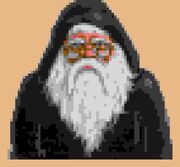
Merlin was once a great wizard from the Other World and in Daventry's legends as well.
Background[]
Merlin was a great magician and the adviser to King Arthur and a number of other kings. It is said that it was Merlin who created the Round Table for his monarch, and perhaps even Stonehenge. Merlin possessed a wondrous mirror which he was able to look into the future or gaze upon anyone or any place he wished. He used it often to help Arthur become victorious in battle.[1]
It is said that the great wizard Merlin had an owl as a familiar. Merlin's Owl was named Archimedes. It is possible that Crispin and Cedric are Merlin and Archimedes, living in Serenia under assumed identities.[2] Other legends say that Merlin was buried in a crystal coffin in a cave deep beneath the earth, somewhere in Daventry with his magic mirror. The tomb of the necromancer was later discovered, and the mirror came into the hands of the king's and queens of Daventry. Merlin used the mirror's property of showing the truth, whether of past, present or future.
Behind the scenes[]
Merlin is a character out of the Arthurian legends. Merlin has appeared in other Sierra games including Conquests of Camelot and another version in Quest for Glory 2 (inspired by Merlin from Disney's version of Once and Future King). Although each is inspired by the same character of myth, each games' version has no connection to the other games directly (although the version that appears in QFG2 also leads to a reference to Conquests of Camelot game).
The crystal coffin is a reference to Merlin being enchanted, and trapped in a crystal cave by Nimue (Lady of the Lake) in some versions of Arthurian legend (at least back to a poem by Edwin Muir, published in 1937), or simply a cave (Thomas Malory), underground tomb, or pit in the forest of Darnantes, in others versions she puts him to sleep, trapped in rock or in a tower, or even a tree. It might also be a referenc to same events which occured in Mary Stewart's Arthurian trilogy. In Mary Stewart's 1979 novel The Last Enchantment radically recasts the story of Merlin and Niniane, completely removing the aspect of malicious seduction and treachery dominant in the traditional version. In this depiction Merlin takes Niniane on as an apprentice, with her at first disguised as a boy, and willingly teaches her his magic. When her identity as a woman is discovered, they fall in love despite their age difference. As he gives her the secrets of his psychic abilities and how to control them, he seems to lose them himself – which Merlin does not mind. In a depleted, weakened condition, he takes ill and falls into a coma, and is believed to be dead. Niniane has him buried within his "crystal cave", where he awakes some time later. He escapes after a few weeks, through a combination of chance luck and ingenious planning, and travels incognito to let Arthur know he is still alive. Niniane takes Merlin's place as the court wizard-seer, while Merlin retires to the crystal cave and lives a quiet and happy life as a hermit.
Another possibly reference is in late Welsh legend in which has him make a voluntary retreat to an underground wyr or invisible glass house on Bardsey Island. There he guards the Thirteen Treasures of Britain along with the True Throne of the Realm where Arthur will sit upon his return. It is possible that the "Magic Mirror" was one of these thirteen treasures.
Merlin is similar to Haroun alRaschid in King's Quest lore in that the final outcome of both wizards is wrapped in mystery. Both are believed to have possible died, or perhaps still live on, but under other guises. Merlin as Crispin, and Harun possibly an aardvark. In an interesting ironic coincidence, Halroun is said to be the only magician the green isles had ever known (not counting the wizard who may have created the Isle of Wonder), and Crispin inexplicably knew of the location of the Green Isles, as if he had been there before.